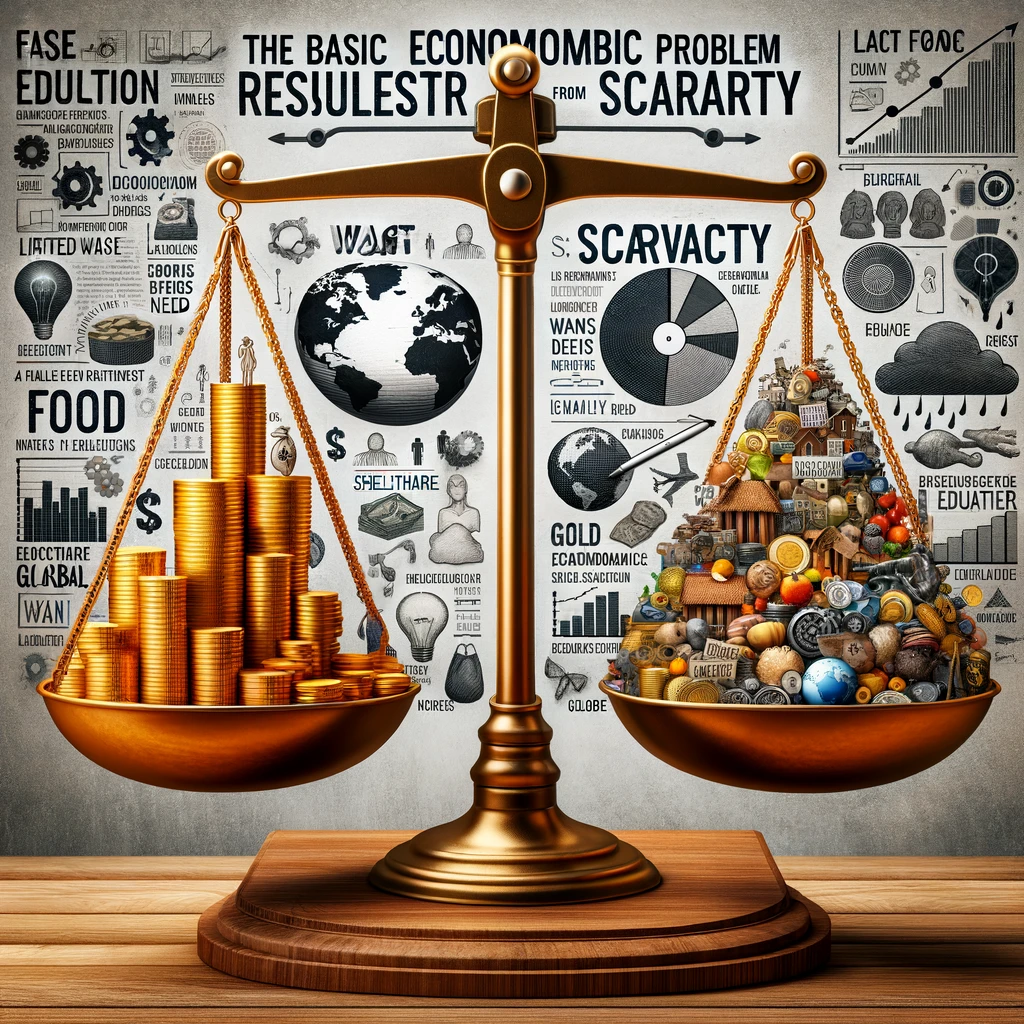In the world of economics, one fundamental issue shapes the behavior of individuals, businesses, and governments: scarcity. The basic economic problem results from scarcity. This concept is pivotal to understanding how resources are allocated and why choices must be made. Scarcity refers to the limited nature of resources, which means there are not enough resources to satisfy all human wants and needs. This article delves into the concept of scarcity, how it drives the basic economic problem, and its implications for economic decision-making. You can also read this Eddie Bauer High Chair Cover: Protect Your High Chair with Style and Ease
What is Scarcity?
Scarcity is a fundamental concept in economics that describes the situation where limited resources are insufficient to meet unlimited wants and needs. Resources such as time, money, labor, and raw materials are finite. Consequently, individuals, businesses, and governments must make choices about how to allocate these limited resources most efficiently.
Types of Resources
- Natural Resources: These include land, water, minerals, and other raw materials provided by nature.
- Human Resources: This encompasses labor, skills, and knowledge possessed by people.
- Capital Resources: These are man-made resources such as machinery, buildings, and technology used in the production of goods and services.
- Entrepreneurial Resources: This refers to the vision, risk-taking, and innovation brought by entrepreneurs.
The Basic Economic Problem
The basic economic problem results from scarcity and forces individuals and societies to make choices about how to allocate their limited resources. Because we cannot have everything we want, we must prioritize our needs and wants, leading to the necessity of making trade-offs.
Unlimited Wants and Limited Resources
Humans have unlimited wants and needs, but the resources available to satisfy these wants are limited. This disparity creates a basic economic problem. For example, a government may need to decide whether to allocate its budget to healthcare, education, or infrastructure, as it cannot fully fund all sectors simultaneously.
Opportunity Cost
Opportunity cost is the value of the next best alternative foregone when a choice is made. It is a direct consequence of scarcity. When resources are used for one purpose, the opportunity to use them for another purpose is lost. Understanding opportunity cost helps individuals and organizations make better-informed decisions.
Economic Decision-Making
Economic decision-making involves choosing how to allocate scarce resources to satisfy various wants and needs. This process is influenced by factors such as prices, preferences, and societal norms. The basic economic problem results from scarcity and shapes the decision-making processes of consumers, businesses, and governments.
Consumer Choices
Consumers face decisions daily about how to spend their limited income. They must prioritize their needs and wants, deciding what to purchase and what to forgo. For instance, a person may need to choose between buying groceries and paying for a gym membership.
Business Decisions
Businesses also grapple with scarcity. They must decide how to allocate their limited resources, such as capital, labor, and raw materials, to maximize profits. A company may need to choose between investing in new technology or expanding its workforce.
Government Policies
Governments face the challenge of allocating public resources to various sectors such as healthcare, education, defense, and infrastructure. These decisions are often influenced by political, social, and economic factors. Scarcity necessitates prioritizing some projects over others, leading to debates and discussions about the best use of public funds.
The Impact of Scarcity on Markets
Scarcity affects market behavior, influencing supply, demand, and prices. When resources are scarce, they become more valuable, and their prices tend to rise. Conversely, when resources are abundant, their prices usually fall.
Supply and Demand
The basic economic problem results from scarcity, which directly impacts the laws of supply and demand. When a resource is scarce, the supply is limited, leading to higher prices. Conversely, when a resource is plentiful, the supply increases, resulting in lower prices.
Price Mechanism
Prices act as signals in a market economy, guiding the allocation of resources. High prices indicate scarcity, prompting producers to supply more and consumers to demand less. Low prices suggest abundance, encouraging higher consumption and reduced production. The price mechanism helps balance supply and demand, ensuring efficient resource allocation.
Scarcity and Economic Systems
Different economic systems address the basic economic problem resulting from scarcity in various ways. These systems include traditional, command, market, and mixed economies.
Traditional Economy
In traditional economies, customs and traditions determine the allocation of resources. This system relies on historical practices and community-based decision-making. While it can be stable and sustainable, it may lack the flexibility to adapt to new challenges and opportunities.
Command Economy
A command economy, also known as a planned economy, is one where the government centrally controls resource allocation. The government makes decisions about what to produce, how to produce it, and for whom it is produced. While this system can quickly mobilize resources for large-scale projects, it may suffer from inefficiency and lack of innovation.
Market Economy
In a market economy, resource allocation is determined by the interactions of consumers and producers in the marketplace. Prices, driven by supply and demand, guide economic decisions. This system promotes efficiency and innovation but may lead to inequality and market failures.
Mixed Economy
A mixed economy combines elements of both market and command economies. Governments intervene to correct market failures and provide public goods, while market forces drive most economic activities. This system aims to balance efficiency with equity and public welfare.
The Role of Economics in Addressing Scarcity
Economics plays a crucial role in addressing the basic economic problem resulting from scarcity. By studying how resources are allocated and how decisions are made, economists develop theories and models to understand and predict economic behavior.
Economic Theories and Models
Economic theories and models provide frameworks for analyzing how scarcity influences decision-making. These tools help economists understand the trade-offs and opportunity costs involved in resource allocation. They also guide policymakers in designing effective economic policies.
Policy Implications
Economics informs public policy by providing insights into how scarcity affects society. Policymakers use economic analysis to design policies that promote efficient resource allocation, economic growth, and social welfare. For example, policies aimed at improving education and healthcare can enhance human capital, leading to long-term economic benefits.
Overcoming Scarcity
While scarcity is an inherent part of the human condition, societies can take steps to mitigate its effects. Innovation, technological advancement, and sustainable practices can help overcome the limitations imposed by scarce resources.
Technological Innovation
Technological innovation can increase the efficiency of resource use and expand the availability of resources. For example, advances in agricultural technology can boost food production, while renewable energy technologies can provide sustainable alternatives to fossil fuels.
Sustainable Practices
Adopting sustainable practices can help conserve scarce resources for future generations. This includes reducing waste, recycling, and using resources more efficiently. Sustainable development aims to balance economic growth with environmental preservation and social equity.
Education and Human Capital
Investing in education and human capital can enhance the ability of individuals and societies to address scarcity. Education improves skills and knowledge, enabling people to make better decisions and innovate solutions to economic problems.
Conclusion
The basic economic problem results from scarcity, a fundamental issue that shapes economic behavior and decision-making. Scarcity forces individuals, businesses, and governments to make choices about how to allocate limited resources to satisfy unlimited wants and needs. Understanding scarcity and its implications is essential for making informed economic decisions and developing policies that promote efficient resource use and social welfare. By embracing innovation, sustainable practices, and education, societies can mitigate the challenges posed by scarcity and work towards a more prosperous and equitable future.



